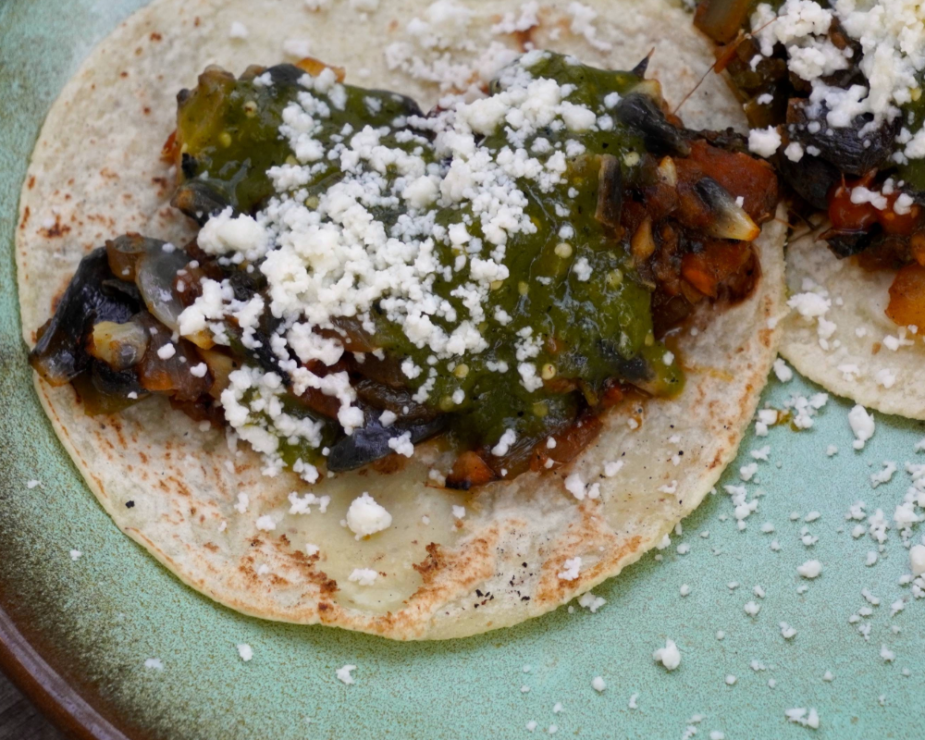
Twenty years ago, in Rick Bayless’s Mexican Kitchen I wrote, “What words can ready you for the flavors and textures that will fill your mouth with each bite of a huitlacoche taco? Earthy? Herby? Sweet? Delicious? Can words capture a unique flavor, or do they simply send you in search of comparisons that distract from the singularity of the experience? There simply is nothing like huitlacoche, and if you've never tasted it, I doubt there's anything I can say that will make it easier or more thrilling for you to take that first bite of black fungus.” I still stand firmly behind those words, though nowadays a lot of my States-side compatriots have had it often enough that huitlacoche no longer seems terribly exotic. Late summer, you can find it in some farmers markets; lots of chefs–even those who don’t cook Mexican–have put it on their menus, and loads of adventurous travelers have sought it out on trips to Mexico City and beyond.
Huitlacoche is an expensive delicacy in Mexico. At the grand Merced Market in the ancient part of Mexico City, during rainy season the wild mushroom vendors display whole ears of huitlacoche-filled corn nestled in crumpled newspaper to protect the fragile lobes from damage. As the ears of corn were first forming, huitlacoche spores traveled down some of the corn silks, ultimately growing within those kernels and causing them to balloon up with an alien-looking gray-blackness. I can’t imagine the curiosity that must have possessed the first indigenous cooks who tried it, but I do understand why they christened it “excrement of the gods” in the Aztec’s language.
This recipe is written for fresh or frozen huitlacoche–the kind we get from a local farmer for our restaurants. While scientists in the United States have developed a method for inoculating corn with huitlacoche spores (for years the same group worked to get rid of it), only a few specialty farmers have been farsighted enough to perceive that there is a market for the stuff. If harvested immature, the lobes will be tight and bitter, if picked too mature, they'll crumble into an overripe mess. Though canned huitlacoche is available in many Mexican grocery stores, most brands are mushy and muddy-tasting, having about as much appeal as canned asparagus. If you find jarred ones in which the lobes or kernels of huitlacoche are still intact, feel free to use it.
I like these tacos with roasted tomatillo salsa.
INGREDIENTS
- 2 fresh poblano chiles
- 2 tablespoons olive or vegetable oil
- 1 medium white onion, chopped into ¼-inch pieces
- 4 cloves garlic, peeled and finely chopped
- 2 cups packed, roughly chopped lobes of huitlacoche OR 2 cups jarred huitlacoche, drained
- 1 medium tomato, chopped into ¼-inch pieces
- 2 to 3 tablespoons chopped epazote leaves (or a big handful of cilantro, if no epazote is available)
- 12 warm corn tortillas
- ¾ cup salsa (I like Roasted Tomatillo Salsa - recipe linked above)
- A scant cup crumbled Mexican queso fresco or other fresh cheese such as feta or goat cheese
INSTRUCTIONS
Make the filling. Roast the chiles directly over a gas flame or 4 inches below a very hot broiler until blackened on all sides (about 5 minutes for open flame, 10 minutes for broiler), cool until handleable, then peel, remove stem and seeds, and rinse briefly. Chop into ¼-inch bits.
In a very large (12-inch) skillet, heat the oil over medium. Add the onion and cook, stirring regularly, until lightly browned, about 7 minutes. Add the garlic, stir for a minute or so, then add the huitlacoche and cook, undisturbed for 2 to 3 minutes to concentrate the flavor. Stir in the tomato, poblano and epazote, and cook, stirring frequently, until the tomato juices are reduced and thick, about 8 minutes. Taste and season with salt, usually about 1 teaspoon.
Serve. Make tacos with about ¼ cup of the filling, a spoonful of salsa and a generous sprinkling of cheese.




